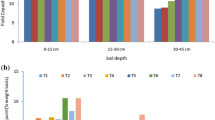Abstract
Rice is cultivated through transplanting of seedling in submerged field which is a cumbersome, labour intensive and water-guzzling practice. A field experiment was conducted to study the effect of crop establishment methods and irrigation schedules on water productivity, economics and energetics of aerobic direct-seeded rice at Punjab Agricultural University, Ludhiana, India, during Kharif 2012–2013. The experiment was laid out in split plot design, keeping combinations of two tillage system (no-tillage and conventional tillage) and two methods of sowing (uni-directional and bi-directional) in main plots and four irrigation schedule [(30, 45, 60 and 75 mm CPE (cumulative pan evaporation)] in sub plots. Aerobic direct-seeded rice sown after conventional tillage gave significantly higher grain yield than no-till with 15.4 % higher water expense efficiency. The energy gain and net monetary returns were 13.2 and 21.2 % higher in conventional sown crop than no-till, respectively. Bi-directional sowing resulted in 26.5 % higher grain yield than uni-directional with no effect on quality traits of grains. The net energy gain and net monetary returns were 26.5 thousands MJ/ha and 125.3 $/ha higher from bi-directional sown crop than uni-directional sown crop. Crop irrigated at 30 mm CPE schedule resulted in significantly higher grain yield than that irrigated at 45, 60 and 75 mm CPE. The energy gain, energy use efficiency and net returns were also maximum at 30 CPE schedule than at 45, 60 or 75 CPE. However, brown, milled and head rice recoveries were statistically at par between irrigation scheduling at 30 and 45 mm CPE but significantly better than 60 and 75 mm CPE. Bi-directional sowing with conventional tillage and irrigation at 30 CPE is an energy efficient and economical viable technique for direct-seeded rice.

Similar content being viewed by others
References
Anonymous (2014) Package of Practices for Kharif Crops. Punjab Agricultural University, Ludhiana
Bouman BAM (2009) How much water does rice use? Rice Today 8:28–29
Brar SK, Mahal SS, Brar AS, Vashist KK, Sharma Neerja, Buttar GS (2012) Transplanting time and seedling age affect water productivity, rice yield and quality in north-west India. Agric Water Manag 115:217–222
Demircan V, Ekinci K, Keener MH, Akbolat D, Ekinci C (2006) Energy and economic analysis of sweet cherry production in Turkey: a case study from Isparata province. Energy Conserv Manag 47:1761–1769
Gajri PR, Arora VK, Prihar SS (1992) Tillage management for efficient water and nitrogen use in wheat following rice. Soil Tillage Res 24:167–182
Gajri PR, Gill KS, Singh R, Gill BS (1999) Effect of preplanting tillage on crop yields and weed biomass in a rice-wheat system on a sandy-loam soil in Punjab. Soil Tillage Res 52:83–89
Gangwar KS, Singh HR (2010) Effect of rice (Oryza sativa L.) crop establishment technique on succeeding crops. Indian J Agric Sci 80:24–28
Huang M, Zou Y, Jiang P, Xia B, Feng Y, Cheng Z, Mo Y (2012) Effect of tillage on soil and crop properties of wet seeded flooded rice. Field Crop Res 129:228–238
Hussain I, Khan MA, Ahmad K (2003) Effect of row spacing on the grain yield and yield component of wheat (Triticum aestivum). Pakistan J Agron 2(3):153–159
Khade VN, Patil BD, Khanvilakr SA, Chavan LS (1993) Effect of seeding rates and level of N on yield of direct seeded (Rahu) summer rice in Konkan. J Maharashtra Agric Uni 18:32–35
Khush GS (2004) Harnessing science and technology for sustainable rice-based production systems. Proceedings FAO Rice Conference “Rice is life”. IRRN 53:17–23
Kirchhof G, So HB (1996) Management of clay soils for rainfed lowland rice-based cropping systems. In: Proceedings ACIAR International Workshop. ACIAR, Canberra, Australia, p. 259
Mann RA, Munir M, Haqqani AM (2004) Effect of resource conserving techniques on crop productivity in rice-wheat cropping system. Pakistan J Agric Res 18:76–82
NAREGA (2005) Mahatama Gandhi National Employment Guarantee Act. Ministery of Rural Development—Government of India. http://www.nrega.nic.in
Pandey S, Velasco L (1999) Economics of direct seeding in Asia. Pattern of adoption and research priorities. IRRI Newsl 24:6–11
Ramakrishna Y, Singh S, Parihar SS (2007) Influence of irrigation regime and nitrogen management on productivity, nitrogen uptake and water use by rice (Oryza sativa). Indian J Agron 52:102–106
Singh VPN, Uttam SK (1993) Performance of wheat cultivars under different sowing methods and fertility levels in Central Uttar Pradesh. Indian J Agron 38:285–287
Singh TG, Badaruddin UM, Meisner C (1998) Cultivar, nitrogen and moisture effects on a rice-wheat sequence: experimentation and simulation. Agronomy J 90:119–130
Singh Y, Singh VP, Singh G, Yadav DS, Sinha RKP, Johnson DE, Mortimer AM (2011) The implications of land preparation, crop establishment method and weed management on rice yield variation in the rice—wheat system in the Indo-Gangetic plains. Field Crop Res 121:64–74
Panesar BB, Bhatnagar AP (1994) Energy norms for inputs and outputs of agricultural sector. In: Verma SR, Mittal JP, Singh S (eds) Energy management and conservation in agricultural production and food processing. USG Publishers & Distributors, Ludhiana, pp 5–16
Author information
Authors and Affiliations
Corresponding author
Rights and permissions
About this article
Cite this article
Singh, H., Buttar, G.S., Brar, A.S. et al. Crop establishment method and irrigation schedule effect on water productivity, quality, economics and energetics of aerobic direct-seeded rice (Oryza sativa L.). Paddy Water Environ 15, 101–109 (2017). https://doi.org/10.1007/s10333-016-0532-4
Received:
Revised:
Accepted:
Published:
Issue Date:
DOI: https://doi.org/10.1007/s10333-016-0532-4




